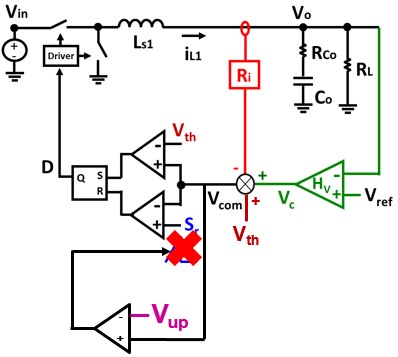LIBRARY
Improved Current-Mode Control with Single-Cycle Load-Transient

The fastest transient response can be achieved using a single-step transient. Two methods to improve the load step-up transient performance of COT and RPM to achieve a single-step transient response are proposed. For both methods, transient detection utilizes the Vcom signal. Unlike RPM, COT does not use Vcom however, Vcom can be created using the COT control signals.
For the first method, shown in Fig 1 using RPM as an example, Vcom and a single Vup, placed above Vth, are used to determine transient. Transient is determined when Vcom increases higher than Vup and ends when Vcom decreases below Vth. During transient, Sr is turned off to extend Ton. Once transient ends, normal control operation is resumed and a single-step load step-up transient response is achieved. This method is extended to the multiphase operation but undesirable ringback can be observed due to total phase overlapping while using the original control scheme to turn off Ton.
For the second method, shown in Fig 2 using RPM as an example, Vcom and two Vup thresholds are used to determine transient. Transient is determined when Vcom increases higher than Vup1, placed above Vth, and ends when Vcom reaches Vup2, placed at Vcom_min. During transient, an additional K*Vc signal is injected into the Vcom signal that is compared with Sr only. This does not affect the Vcom used for transient detection or any other part of the control. The gain of the injected signal, K, must be high enough such that Sr will not reach the modified signal until the termination of the transient. Once transient ends, the modified Vcom signal drops due to the termination of the injected signal, and meets with Sr, thus turning off Ton and a single-step load step-up transient response is achieved. Since this modified transient detection allows the Ton to be terminated once the modified transient detection ends, it allows the Ton to be better controlled in a multiphase operation to alleviate the ringback issue observed in the first method.
For a single-phase, the second method yields the same results as the first method. For multi-phase, the second method relieves the ring-back issue of the first method. Both proposed improvement methods effectively and easily allows a single-step load step-up transient response to be achieved for current-mode controls.























































































